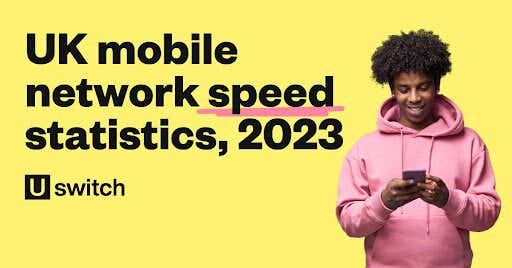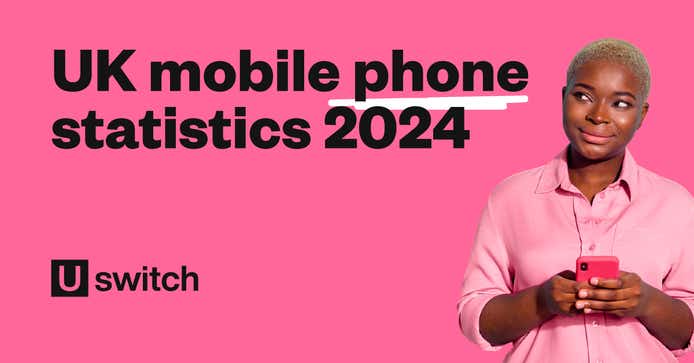In the ever-evolving world of telecommunications, understanding the speed and reliability of mobile networks is paramount. In the UK, mobile network speed statistics are crucial for consumers and businesses alike. In fact, they impact everything, from seamless video streaming to efficient remote working.
With the emergence of 5G technology, and ongoing enhancements in 4G and 3G networks, we’ve decided to analyse how UK mobile network speeds have transformed in the last decade and which parts of the country have the fastest/slowest speeds in 2023.
This piece provides a concise overview of the state of mobile connectivity, covering average speed statistics, network reliability, and the performance of major mobile network providers.
Top 10 mobile network speed statistics
5G adoption in the UK increased from 8% to 25% among mobile users from the end of 2021 to May 2022.
5G offers theoretical download speeds of 10,000 Mbps, whereas typical speeds are closer to 200 Mbps.
Wokingham in England boasts the fastest average download speed, at over 267 Mbps.
Great Yarmouth has the slowest average download speed at just under 19 Mbps.
EE and O2 provide the most reliable 4G networks in the UK, with success rates above 95%.
The response time for 4G networks in the UK averages around 42 milliseconds, with Wi-Fi having the best response time at 19 milliseconds.
The top three places in the UK for download speeds are all in the south-east.
In 2022, the slowest place for uploading in the UK was West Devon.
Throughout 2022, EE’s average median response time was 18.0 m/s, which was 2.2 m/s faster than the next best.
Westminster had more cell antennas than any other local authority.
UK mobile phone speed statistics
Average UK mobile speed statistics - downloading and uploading
5G connections are becoming increasingly common in the UK. In May 2022, 25% of mobile phone users connected to a 5G network, compared to just 8% at the end of 2021.
When comparing mobile phone download speeds, 5G should theoretically provide the fastest service for mobile customers, with 10,000Mbps. However, in reality, it typically only provides 2% of this.
Both types of 4G service will only supply 13-14% of their theoretical download speed, whereas 3G download speeds are closest in terms of their typical speed (42%). At only 3Mbps however, these are the slowest speeds available on the market.
A breakdown of theoretical and typical speeds by network generation
| Network type | Theoretical download speed (Mbps) | Typical download speed (Mbps) | Theoretical upload speed (Mbps) | Typical upload speed (Mbps) |
|---|---|---|---|---|
| 3G | 7 | 3 | 2 | 0.4 |
| 3G HSPA+ | 42 | 6 | 22 | 3 |
| 4G LTE | 150 | 20 | 50 | 5 |
| 4G LTE-Advanced | 300 | 42 | 150 | 10 |
| 5G | 10,000 | 200 | 1000 | 12.0-20.0 |
(Source: 4G)
When it comes to upload speeds, 5G should provide you with the fastest service (between 12-20 Mbps). However this is only 2% of its full potential, whereas a 4G LTE-Advanced connection should provide slightly less than 5G, at 10Mbps, but this is only 7% of its theoretical speed. Of all networks, 3G HSPA+ is the closest in terms of actual versus theoretical upload speed (13%).
A breakdown of UK average mobile data speed statistics for downloading

Mobile network statistics show that for average download speed, the top 10 areas of the UK are all located in England, predominantly the South East and East Midlands. Wokingham is the fastest location for average download speeds, with over 267 Mbps. This is almost 40% faster than Crawley, in tenth place.
The top three fastest places are all in the South East. Oadby and Wigston is the fourth fastest in the UK, and the fastest in the East Midlands, with average download speeds of over 180 Mbps.
By contrast, Great Yarmouth is the slowest place in the UK for average download speeds. From the 324 tests conducted in the area, the average speed was just under 19 Mbps – more than 14 times slower than the fastest location, Wokingham.
Newry, Mourne and Down is the second slowest location in the UK for download speed and one of four locations from Northern Ireland in the bottom 10. The Scottish Borders, in third with 23.57 Mbps, is the only representative from Scotland on this list.
The Isle of Anglesey was the seventh slowest for mobile data speed, yet the slowest in Wales with just over 26 Mbps on average.
A breakdown of UK average mobile data speed statistics for uploading

When comparing mobile phone upload speed across the UK, England continues to dominate the top 10. The top three remain the same for upload speeds as they did for download speeds, with Wokingham providing the fastest once again, at 41.55 Mbps.
Watford, in the East of England, was in fourth place, with an average upload speed almost half that of Wokingham.
Leicester is the highest place from the East Midlands with 20.82 Mbps, narrowly edging the City of London in fifth, with 20.37 Mbps.
Conversely, mobile network statistics show that West Devon is the slowest part of the UK for uploading, with average speeds of just 6.37 Mbps. Angus, in second place, is the only representative from Scotland, with just over 7 Mbps. The Welsh local authority of Denbighshire is in fourth (the only location from Wales in the bottom 10), with Newry, Mourne and Down in ninth as the only local authority from Northern Ireland.
South Norfolk completes the bottom 10 for mobile uploading, with an average mobile data speed of 7.94 Mbps – five times slower than the fastest location, Wokingham.
Reliability of UK mobile data connections
With an overwhelming 82% of mobile connections, 4G is the most reliable UK network, with a success rate of over 95%. By comparison, 3G occupies less than a fifth (17%) of the total mobile network, yet still maintains a success rate of over 93%.
A breakdown of the connectivity of 3G, 4G and 5G
| Percentage of mobile connections | How often UK mobiles are able to connect to this network (%) | Rural | Urban | |
|---|---|---|---|---|
| 4G | 82% | 95.60% | 95.70% | 95.50% |
| 3G | 17% | 93.20% | 91.80% | 93.40% |
| 5G | 0% | 92.70% | 0% | 92.70% |
Percentages refer to the percentage of connection tests recorded as successful while the phone’s screen was on; data refer to 1 January to 31 March 2021; the sample size for 5G connections is 0.2% of the sample size for 4G (39k vs 25m) so the figure should be taken as indicative only; sample size for 5G rural connections is too low for this analysis.
(Source: Ofcom)
Incidentally, there isn’t a substantial difference in mobile data speeds between rural and urban areas. However, 3G's success rate is about 1.5% greater in urban areas. This could be explained by the fact that 3G connections are more likely to be on the edge of a network where a 4G network is unavailable.
A breakdown of network connectivity by service provider
| EE | O2 | Three | Vodafone | |
|---|---|---|---|---|
| 3G | 94.2 | 92.8 | 93.3 | 92.2 |
| 4G | 95.3 | 95.5 | 95.6 | 96 |
| 5G | 92 | 95.9 | 91.4 | 94 |
(Source: Ofcom)
(Note: Percentages refer to the percentage of connection tests recorded as successful while the phone’s screen was on. The data was recorded between 1 January and 31 March 2021. The base size for 5G rural tests is too low to show at this level of study.)
At a UK level, there is very little difference in the 4G data service made available by the four major UK network providers. Vodafone is slightly ahead at 96%, however, the other three all recorded levels above 95%. Despite this, 3G connections on the Vodafone network were less likely to succeed than those on EE, with 92.2% compared to 94.2%.
Where Three does perform strongly is that it is the best network for roaming. Their feel-at-home scheme covers over 71 worldwide, which is more than any other network.
A breakdown of the success rate of different mobile network generations
| Share of mobile connections | Success rate | Rural | Urban | |
|---|---|---|---|---|
| 4G | 82% | 93.80% | 94.00% | 93.80% |
| 3G | 17% | 89.80% | 88.20% | 90.10% |
| 5G | 0% | 92.10% | 0% | 92.10% |
(Source: Ofcom)
While the screen was inactive, the success rates between different networks saw a considerable decrease. 3G connectivity dropped below 90%, while 4G maintained a high success rate of 93.8%. Between rural and urban areas, 3G dropped to just over 88% in the UK countryside and just over 90% in UK cities. This was 3-4% below that of 4G services in rural and urban areas of the UK.
Reliability of UK mobile video streaming
Across the UK, EE had the highest proportion of 4G connections that were rated as either ‘good’ or ‘excellent’ for video streaming (81%); 10% of this was down to their rating of ‘excellent’ – more than any other provider.
A breakdown of how reliable UK mobile video streaming is in the UK, by network provider

There was very little difference between O2, Three, and Vodafone for the quality of their mobile video streaming experience, ranging from 72% for O2 and Vodafone to 70% for Three. Despite this, our mobile market statistics page found that O2 customers spent the most time on the internet, suggesting that they have no problem streaming or connecting to the internet.
UK mobile network share by technology
For connections made to the internet between October 2022 to March 2023, over a third (37.7%) were from mobile devices, compared to almost two-thirds (63%) for Wi-Fi.
A breakdown of mobile phone connections by types of network 2023

UK mobile phone market statistics show that people in urban areas are more likely to be connected to a 4G mobile network than those in rural areas of the UK (88.2% vs 84.7%, respectively). This is due to better mobile phone coverage and management choices by network operators in UK cities.
A breakdown of UK mobile phone network share by technology and rurality
| Rural | Urban | |
|---|---|---|
| 5G | 2.60% | 4.70% |
| 4G | 84.70% | 88.20% |
| 3G | 9.00% | 5.50% |
| 2G | 0.80% | 2.10% |
(Source: Ofcom)
Comparative figures for 3G slightly favour rural than urban areas (9.0% vs 5.5%), whereas 2G networks are rarely connected to by UK mobile users, at 2% for rural areas and under 1% for urban areas.
Our UK mobile phone network speed statistics suggest that 4G speeds in rural areas are only 3.5 percentage points slower than those in urban areas.
A breakdown of UK mobile network share by technology and network operator
| Mobile | Wi-Fi | |
|---|---|---|
| EE | 40.10% | 59.90% |
| O2 | 33.50% | 66.50% |
| Vodafone | 38.80% | 61.20% |
| Three | 37.70% | 62.30% |
(Source: Ofcom)
UK mobile market statistics indicate that O2 users were the ones who spent the most time connected to Wi-Fi, with two-thirds (66.5%) of their time online spent on Wi-Fi. For Vodafone this figure was 62.3%, for Three it was 61.2% and for EE it was 59.9%.
A breakdown of the main UK network providers and their network connections

Of these mobile-only connections, 90.9% of those on the EE network connect to a 4G network, compared to 86.8% for Three. However, the Three network is more popular for 3G connections, with just over a twentieth (6.8%), but only 2.7% for EE.
This is down to differing levels of 4G network coverage across the UK and different providers' approaches to how they manage their networks. It should also be acknowledged that, for certain low-demand mobile activities, such as browsing the web or reading an email, a 3G connection is just as good and provides a similar web experience as a 4G connection.
Therefore, operators may choose 3G as a default connection option in areas with a weaker signal or increased network congestion. This will enable them to provide a more reliable connection service while helping to manage the overall network capacity.
UK mobile response times for data requests
The time it takes for a network to respond to data requests (such as loading a web page or streaming a programme) can have a significant impact on consumer experience.
In order to qualify for a ‘good experience’, most mobile activities need a network response time (or latency rate) of under 100 milliseconds (ms). For more demanding activities, such as video calling, this drops to 50ms, while other activities, such as web browsing, can perform to a satisfactory standard with a slightly slower response time.
A breakdown showing the average response time by network generation
| Network | Average response time (ms) |
|---|---|
| 3G | 61 |
| 4G | 42 |
| 5G | 33 |
| Wi-Fi | 19 |
(Source: Ofcom)
In the UK, mobile network statistics show that the average response times for 4G networks are around 42ms, compared to 61ms for 3G and 33ms for 5G. Wi-Fi had the best response time out of all networks, with 19ms (more than twice as fast as 4G).
A breakdown of UK network response times by country and geography

Across the country, UK response times for 4G networks were significantly different compared to 3G. 4G was fastest in urban areas compared to rural by 4ms, whereas 3G was faster by 6ms.
Between the four nations of the UK, England had the fastest response times for both 3G and 4G networks, whereas Northern Ireland was the least responsive. On average, 4G in England is 10ms faster than in Northern Ireland, compared to 3G, which was 15ms quicker.
Average mobile network speed statistics for latency
When it comes to average latency speeds, the top 10 fastest areas of the UK can all be found in England. The area with the fastest mobile data speed in the UK can be found in the East of England in Watford at 26.8ms. Seven of the top 10 fastest areas in the UK for latency are located in London.
Reading, in third position, is only 0.106ms slower than Barking and Dagenham in second place. Southend-on-Sea is located in ninth, with an average latency speed of over 28.7ms.
A breakdown of UK average mobile data speed statistics for latency

By contrast, mobile network statistics have identified that five of the bottom 10 for average latency speed can be found in Scotland. Na h-Eileanan Siar produced an average lag of 122.8ms (the only location in the UK over 100ms). This happens to be 4.5 times slower than the fastest place in the UK, Watford.
East Lindsay, in the East Midlands, is the only English local authority in the bottom 10, at 99.57ms. Fermanagh and Omagh complete the bottom three. With an average latency speed of 78.54ms, this is also the slowest of the three Northern Ireland local authorities in the bottom 10.
The Isle of Anglesey, in seventh, is the only representative from Wales, with speeds of 65.2ms.
A Breakdown of latency rates across the UK by network provider

Between network providers, average response times were significantly faster on EE for 4G connectivity. At 18.5ms, this was 3.2ms faster than O2, 4.1ms faster than Vodafone, and 5.5ms faster than Three.
EE was once again quicker than its competitors in regards to 5G response time. EE’s average median response time was 18.0 (2.2 ms faster than the next best), which was Three. O2 was the slowest for 5G connection speed, at 21.7ms.
EE’s 4G connection speed was 3.2ms faster than O2’s 5G speed, and 2.7ms faster than Vodafone’s.
It’s worth noting that the top four providers all returned average response times significantly below the 100ms threshold considered for a ‘good’ experience. These slight differences are likely to be unnoticeable to customers, unless the user utilises their mobile phone for services that require a fast connection speed, such as video calling or online gaming.
UK mobile phone statistics indicate that EE is the most popular mobile phone provider, with 26% of survey respondents saying that they used the provider, and it is easy to see why given the speeds that they provide.
Most common mobile phone network in the UK
Results from our Uswitch mobile phone survey suggest that in 2022, 4G was the UK’s most used network.
A breakdown of the most common mobile phone network
| Network | Percentage |
|---|---|
| 2G | 0.80% |
| 3G | 6.20% |
| 4G | 67.50% |
| 5G | 19.50% |
| Other, please specify | 0.30% |
| Unsure/don't know | 5.70% |
(Source: Uswitch, September 2022. 2,000 respondents)
Over two-thirds (67%) of people surveyed connected to a 4G network in the UK, followed by almost 20% for 5G. 3G networks were the next most popular, at just over 6%. However, this was almost the same percentage as those who were unsure, or did not know their mobile phone network.
UK cell antenna statistics
Of the four major network providers in the UK, EE narrowly edges O2 in regards to the number of cell antennas, by just 434.
In total, these operators have more than 1.6 million cell antennas between them, with almost 60% belonging to either EE or O2, around 23% for Vodafone, and almost 18% for Three.
A breakdown of the number of cell antennas in the UK
| Cell Antenna Operator | Number of cell antennas |
|---|---|
| EE | 490,533 |
| O2 | 490,099 |
| Vodafone | 382,803 |
| Three | 296,819 |
(Source: Uswitch, via OpenCellID and ONS)
The City of London ranks as the best place for UK antennas, with more than 514 per 1,000 people. North Warwickshire, in second, has significantly less than the City of London, with 83 per 1,000. Westminster completes the top three, with an impressive 965 per square kilometre and almost 69 per 1,000 residents.
Interestingly, the local authority of Eden, in Cumbria, is placed sixth in the country for the number of antennas per 1,000 people, yet has the lowest rates per square kilometre in the top 10. With a rate of 1.29 antennas per square kilometre, this is also lower than most locations in the bottom 10 for cell antenna access.
A breakdown of the number of cell antennas in the UK per 1,000 people

The Orkney Islands is rated the least accessible part of the UK for cell antennas. With only 166 in total, this averages just over seven per 1,000 people and 0.16 per km².
Coming in fourth is Gosport. Despite having a moderately high rate of nearly 34 cell antennas per square kilometre, the rate of just over 10 per 1,000 people reduces its level of accessibility.
North East Lincolnshire has over 1,800 cell antennas, the highest in the bottom 10. However, due to its relative size and population, this reduces the cell antenna rate to 9.6 per km² and 11.6 per 1,000 people, making it the tenth least accessible location in the UK for cell antennas.
A breakdown of the number of cell antennas in the UK per square kilometre

When considering the number of UK antennas per square kilometre, the top 10 areas can all be found in London. Westminster alone has over 18,500 cell antennas, the fourth highest in the UK, resulting in over 860 per km².
The City of London, however, reigns supreme with almost 1,950 per square kilometre. Despite having the least number of antennas in the top 10, the relatively small area of this local authority produces a significant number per km².
Na h-Eileanan Siar, in the Outer Hebrides, has the fewest cell antennas per square kilometre. This remote Scottish local authority has only 366 cell antennas, resulting in 0.13 per km². The Orkney Islands, with the second lowest density of cell antennas for its area, has less than half this amount, yet is three times smaller than Na h-Eileanan Siar. Consequently, this results in 0.16 antennas per km².
The Highlands, in third place, has a large number of cell antennas (over 6,300). However, with a surface area of over 26,000km² (the largest of any area in the bottom 10), this averages just 0.24 per square kilometre.
All local authorities in the bottom 10 can be found in Scotland, Wales, or Northern Ireland. Powys, in seventh, is the only Welsh location in this list, with 0.6 cell antennas per km², followed closely by Fermanagh and Omagh in eighth with 0.64 per square kilometre.
A breakdown of the 10 local authorities with the most cell antennas by network provider

When broken down by the four major mobile network providers, Westminster has the most, at just under 1,000, followed by Birmingham with 785.
The most EE cell towers can also be found in Westminster (287), however, in this local authority, there are more O2 towers (337). This is the most of any provider across all local authorities in the UK.
The most Three cell towers can be found in Birmingham (193), followed by Leeds (162).
Vodafone cell towers are more common in Westminster (255) and The Highlands, with exactly 200.
A breakdown of the top locations for cell antennas for the four main network providers in the UK

All four providers appear in the top 10 for Westminster, Birmingham, Buckinghamshire, Leeds, and Cornwall.
Almost 10% of the cell towers in the Highlands belong to EE, O2, and Vodafone, whereas the City of Edinburgh is more popular for O2, Three, and Vodafone.
Some local authorities only appear once in the top 10 for each provider:
West Northamptonshire for EE cell towers (174).
Camden and City of London for O2 (150 and 140, respectively).
Bradford, Sheffield, and Liverpool for Three.
Aberdeenshire for Vodafone cell towers.
UK mobile network speed FAQs
How fast is 5G compared to 4G?
A few years ago many were asking what is 5G? 5G is still in the early stage of its evolution, but the hope is that in the right circumstances, 5G download speeds can reach 10Gbps. That is 100 times faster than 5G. It’s why many people are taking out specific 5G mobile phone deals.
Which mobile network has the fastest internet speed?
Mobile network statistics show that the average download speed in the UK is 32Mb. For 5G in 2023, the average download speed is 133.9Mbps.
How fast should 4G be?
Your average 4G mobile download speeds should be between 8-10Mbps.
Methodology and sources
https://www.ofcom.org.uk/__data/assets/pdf_file/0034/249289/connected-nations-uk-report.pdf
Data sources for “Average mobile data speed across the UK for downloading, uploading, and latency” (accessed 24/08/2022):
https://github.com/teamookla/ookla-open-data
Data sources for “UK cell antennas” (accessed on 01/09/2022):
https://opencellid.org/downloads.php
https://en.wikipedia.org/wiki/Mobile_network_codes_in_ITU_region_2xx_(Europe)








